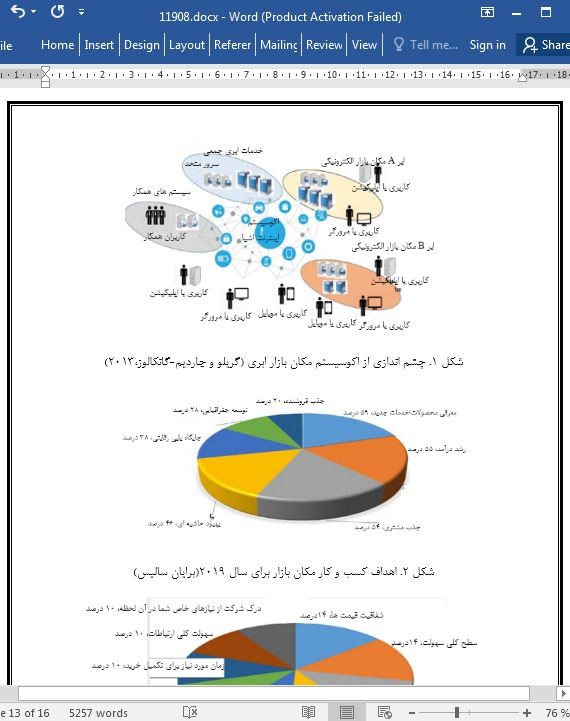
یک بررسی درمورد پلتفرم ها و بازار B2B دیجیتال برای خرید سیستم های خدمات تولید صنعتی
چکیده
تغییر حاشیه سود از محصولات به خدمات، صنایع تامین کننده تجهیزات تولید سنتی را به ارائه دهندگان سیستم های خدمات- تولید صنعتی (IPSS) تغییر داده است. سیستم های خدمات تولید صنعتی یک مدل کسب و کار جدید برای تحویل مستمر محصولات صنعتی مانند تجهیزات تولیدی و خدمات تولیدی (تولید به عنوان یک خدمت) است. با این وجود، خرید سیستم های خدمات تولید صنعتی بین شرکت های صنعتی (مانند بنگاه به بنگاه- B2B) نسبت به مورد محصولات ارائه شده به مصرف کنندگان(یعنی بنگاه به مشتری-B2C)، پیچیده تر است. پیچیدگی در تعامل بین ذینفعان بنگاه به بنگاه، عدم اعتماد و هزینه های بالا به ویژه برای شرکت های کوچک و متوسط، مانع ایجاد مکان بازار الکترونیک استاندارد همانند عرصه بنگاه به مشتری شده است. این تحقیق دیدگاهی درباره الزاماتی برای حمایت از فرآیندهای زنجیره تامین بر روی یک پلتفرم بنگاه به بنگاه دیجیتال ارائه می دهد و همچنین در مورد اهداف و مزایای پلتفرم های چند وجهی بحث شده است.
1.مقدمه
جهانی سازی فعالیت اقتصادی و ظهور اینترنت، در معرفی مدل بنگاه به بنگاه جدید به نام بازار بنگاه به بنگاه و مکان بازارالکترونیکی که روابط بازاریابی بین خریداران و فروشندگان را ارتقا می دهد، نقش داشته است(مایر و همکاران، 2010). عرصه صنعتی جهانی تمایل به تغییر ساختار به سوی پارادایم خدمات دارد. علاوه بر این، بخش صنعت، پیچیده تر شده است و به طرز چشمگیری تحت تاثیر صنعت 4.0 قرار گرفته است(وی و همکاران، 2015). مطابق عصر تولید جدید، هدف صنایع، ارتقا پایداری و رقابت پذیری خود، از طریق تعییر مدل های کسب و کارشان با ارائه سیستم های خدمات تولید(PSS) برای کاربرد تجاری است که به سیستم های خدمات تولید صنعتی(IPSS) صرفا برای کاربرد صنعتی همراه با افزایش همزمان ارزش های محصولات گسترش یافته است(مایر و همکاران، 2010؛ مارتزیس، 2019).
Abstract
The shift of profit margins from products to services, has transformed traditional production equipment supplier industries to providers of Industrial Product-Service Systems (IPSS). IPSS is a new business model for consistent delivery of industrial products such as production equipment and manufacturing services (Manufacturing as a Service). However, procurement of IPSS between industrial companies (i.e. Business-to-Business - B2B) is more complicated compared to the case of products offered to consumers (i.e. Business-to-Consumer – B2C). The complexity in interaction between the involved B2B stakeholders, the lack of trust and high costs especially for Small Medium Enterprises have hampered the establishment of standardized e-marketplaces in a similar manner as in the business to consumer world. This research work presents an overview on the requirements to support supply-chain processes on a digital B2B platform as well as a discussion of the objectives and the benefits of this multi-sided platform.
1. Introduction
The globalization of economic activity and the advent of the Internet have contributed to the introduction of a new Businessto-Business model (B2B) known as the online B2B market or e-Marketplace which promotes marketing relationships between buyers and sellers (Meier et al., 2010). The global industrial world tends to follow the structural change towards the service paradigm. Additionally, the industry sector has become more complex and dynamically affected by the era of Industry 4.0 (Wee et al., 2015). Following the new manufacturing era, the industries aim to enhance their sustainability and competitiveness through shifting their business models by providing Product Service Systems (PSS) for commercial use extending to Industrial Product Service Systems (IPSS) solely for industrial use along with the simultaneous increase of the values of the products (Meier et al., 2010; Mourtzis, 2019).
چکیده
1. مقدمه
2. مروری بر ادبیات
2.1. مکان بازار ابری: چشم انداز و اجزا
2.2. سیستم های خدمات تولید صنعتی
2.3. مکان های بازار الکترونیک
2.4. بنگاه به بنگاه و پلتفرم های بنگاه به بنگاه / مدل های کسب و کار
2.5. رسانه اجتماعی و بازاریابی از طریق موبایل
2.3. مدیریت زنجیره تامین(SCM)
4. نتیجه گیری و چشم انداز
منابع
Abstract
1. Introduction
2. Literature review
2.1. Cloud-Marketplace: vision and components
2.2. Industrial Product Service Systems (IPSS)
2.3. e-Marketplaces
2.4. B2B and B2C platforms/business models
2.5. Social media and mobile marketing
2.6. Supply Chain Management (SCM)
3. Analysis of digital B2B platform and market places for IPSS purchasing
4. Conclusion and outlook
References
- اصل مقاله انگلیسی با فرمت ورد (word) با قابلیت ویرایش
- ترجمه فارسی مقاله با فرمت ورد (word) با قابلیت ویرایش، بدون آرم سایت ای ترجمه
- ترجمه فارسی مقاله با فرمت pdf، بدون آرم سایت ای ترجمه



